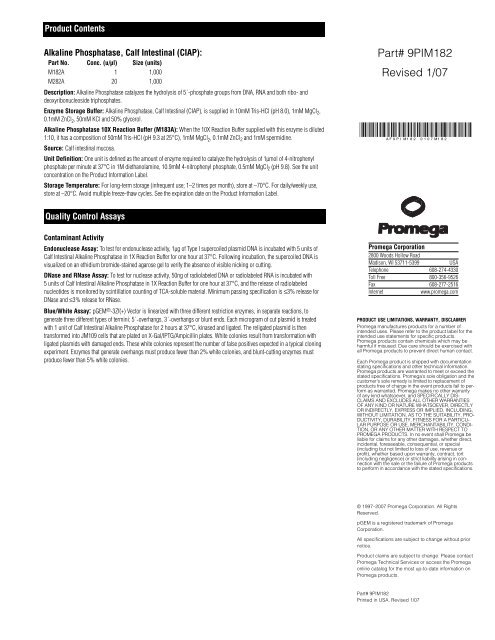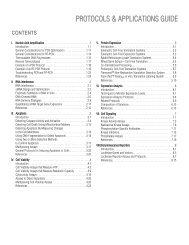Alkaline Phosphatase, Calf Intestinal (CIAP) Product ... - Promega
Alkaline Phosphatase, Calf Intestinal (CIAP) Product ... - Promega
Alkaline Phosphatase, Calf Intestinal (CIAP) Product ... - Promega
You also want an ePaper? Increase the reach of your titles
YUMPU automatically turns print PDFs into web optimized ePapers that Google loves.
<strong>Product</strong> Contents<br />
<strong>Alkaline</strong> <strong>Phosphatase</strong>, <strong>Calf</strong> <strong>Intestinal</strong> (<strong>CIAP</strong>):<br />
Part No. Conc. (u/µl) Size (units)<br />
M182A 1 1,000<br />
M282A 20 1,000<br />
Description: <strong>Alkaline</strong> <strong>Phosphatase</strong> catalyzes the hydrolysis of 5´-phosphate groups from DNA, RNA and both ribo- and<br />
deoxyribonucleoside triphosphates.<br />
Enzyme Storage Buffer: <strong>Alkaline</strong> <strong>Phosphatase</strong>, <strong>Calf</strong> <strong>Intestinal</strong> (<strong>CIAP</strong>), is supplied in 10mM Tris-HCl (pH 8.0), 1mM MgCl2, 0.1mM ZnCl2 , 50mM KCl and 50% glycerol.<br />
<strong>Alkaline</strong> <strong>Phosphatase</strong> 10X Reaction Buffer (M183A): When the 10X Reaction Buffer supplied with this enzyme is diluted<br />
1:10, it has a composition of 50mM Tris-HCl (pH 9.3 at 25°C), 1mM MgCl2 , 0.1mM ZnCl2 and 1mM spermidine.<br />
Source: <strong>Calf</strong> intestinal mucosa.<br />
Unit Definition: One unit is defined as the amount of enzyme required to catalyze the hydrolysis of 1µmol of 4-nitrophenyl<br />
phosphate per minute at 37°C in 1M diethanolamine, 10.9mM 4-nitrophenyl phosphate, 0.5mM MgCl2 (pH 9.8). See the unit<br />
concentration on the <strong>Product</strong> Information Label.<br />
Storage Temperature: For long-term storage (infrequent use; 1–2 times per month), store at –70°C. For daily/weekly use,<br />
store at –20°C. Avoid multiple freeze-thaw cycles. See the expiration date on the <strong>Product</strong> Information Label.<br />
Quality Control Assays<br />
Contaminant Activity<br />
Endonuclease Assay: To test for endonuclease activity, 1µg of Type I supercoiled plasmid DNA is incubated with 5 units of<br />
<strong>Calf</strong> <strong>Intestinal</strong> <strong>Alkaline</strong> <strong>Phosphatase</strong> in 1X Reaction Buffer for one hour at 37°C. Following incubation, the supercoiled DNA is<br />
visualized on an ethidium bromide-stained agarose gel to verify the absence of visible nicking or cutting.<br />
DNase and RNase Assay: To test for nuclease activity, 50ng of radiolabeled DNA or radiolabeled RNA is incubated with<br />
5 units of <strong>Calf</strong> <strong>Intestinal</strong> <strong>Alkaline</strong> <strong>Phosphatase</strong> in 1X Reaction Buffer for one hour at 37°C, and the release of radiolabeled<br />
nucleotides is monitored by scintillation counting of TCA-soluble material. Minimum passing specification is ≤3% release for<br />
DNase and ≤3% release for RNase.<br />
Blue/White Assay: pGEM ® -3Zf(+) Vector is linearized with three different restriction enzymes, in separate reactions, to<br />
generate three different types of termini: 5´-overhangs, 3´-overhangs or blunt ends. Each microgram of cut plasmid is treated<br />
with 1 unit of <strong>Calf</strong> <strong>Intestinal</strong> <strong>Alkaline</strong> <strong>Phosphatase</strong> for 2 hours at 37°C, kinased and ligated. The religated plasmid is then<br />
transformed into JM109 cells that are plated on X-Gal/IPTG/Ampicillin plates. White colonies result from transformation with<br />
ligated plasmids with damaged ends. These white colonies represent the number of false positives expected in a typical cloning<br />
experiment. Enzymes that generate overhangs must produce fewer than 2% white colonies, and blunt-cutting enzymes must<br />
produce fewer than 5% white colonies.<br />
Part# 9PIM182<br />
Revised 1/07<br />
AF9PI M182 0107M182<br />
<strong>Promega</strong> Corporation<br />
2800 Woods Hollow Road<br />
Madison, WI 53711-5399 USA<br />
Telephone 608-274-4330<br />
Toll Free 800-356-9526<br />
Fax 608-277-2516<br />
Internet www.promega.com<br />
PRODUCT USE LIMITATIONS, WARRANTY, DISCLAIMER<br />
<strong>Promega</strong> manufactures products for a number of<br />
intended uses. Please refer to the product label for the<br />
intended use statements for specific products.<br />
<strong>Promega</strong> products contain chemicals which may be<br />
harmful if misused. Due care should be exercised with<br />
all <strong>Promega</strong> products to prevent direct human contact.<br />
Each <strong>Promega</strong> product is shipped with documentation<br />
stating specifications and other technical information.<br />
<strong>Promega</strong> products are warranted to meet or exceed the<br />
stated specifications. <strong>Promega</strong>'s sole obligation and the<br />
customer's sole remedy is limited to replacement of<br />
products free of charge in the event products fail to perform<br />
as warranted. <strong>Promega</strong> makes no other warranty<br />
of any kind whatsoever, and SPECIFICALLY DIS-<br />
CLAIMS AND EXCLUDES ALL OTHER WARRANTIES<br />
OF ANY KIND OR NATURE WHATSOEVER, DIRECTLY<br />
OR INDIRECTLY, EXPRESS OR IMPLIED, INCLUDING,<br />
WITHOUT LIMITATION, AS TO THE SUITABILITY, PRO-<br />
DUCTIVITY, DURABILITY, FITNESS FOR A PARTICU-<br />
LAR PURPOSE OR USE, MERCHANTABILITY, CONDI-<br />
TION, OR ANY OTHER MATTER WITH RESPECT TO<br />
PROMEGA PRODUCTS. In no event shall <strong>Promega</strong> be<br />
liable for claims for any other damages, whether direct,<br />
incidental, foreseeable, consequential, or special<br />
(including but not limited to loss of use, revenue or<br />
profit), whether based upon warranty, contract, tort<br />
(including negligence) or strict liability arising in connection<br />
with the sale or the failure of <strong>Promega</strong> products<br />
to perform in accordance with the stated specifications.<br />
© 1997–2007 <strong>Promega</strong> Corporation. All Rights<br />
Reserved.<br />
pGEM is a registered trademark of <strong>Promega</strong><br />
Corporation.<br />
All specifications are subject to change without prior<br />
notice.<br />
<strong>Product</strong> claims are subject to change. Please contact<br />
<strong>Promega</strong> Technical Services or access the <strong>Promega</strong><br />
online catalog for the most up-to-date information on<br />
<strong>Promega</strong> products.<br />
Part# 9PIM182<br />
Printed in USA. Revised 1/07
I. Description<br />
<strong>Calf</strong> intestinal alkaline phosphatase (<strong>CIAP</strong>) catalyzes the hydrolysis of 5´-phosphate<br />
groups from DNA, RNA, and ribo- and deoxyribonucleoside triphosphates. This<br />
enzyme is used to prevent recircularization and religation of linearized cloning<br />
vehicle DNA by removing phosphate groups from both 5´-termini (1–5).<br />
II. Reaction Conditions<br />
A. Dephosphorylation of 5´ Overhangs<br />
Reagents to Be Supplied by the User<br />
(Solution compositions are provided in Section III.)<br />
• 10mM Tris-HCl (pH 8.0)<br />
• <strong>CIAP</strong> stop buffer<br />
• TE-saturated phenol:chloroform<br />
• chloroform:isoamyl alcohol (24:1)<br />
• 7.5M ammonium acetate (pH 5.5)<br />
• ethanol, 100% and 70%<br />
1. Dilute sufficient <strong>CIAP</strong> for immediate use in <strong>CIAP</strong> 1X Reaction Buffer to a final<br />
concentration of 0.01u/µl. Each picomole of DNA ends will require 0.01u <strong>CIAP</strong>.<br />
(1µg of 1,000bp DNA = 1.52pmol DNA = 3.03pmol of ends.)<br />
2. Purify the DNA to be dephosphorylated by ethanol precipitation, and resuspend<br />
the pellet in 40µl of 10mM Tris-HCl (pH 8.0). Set up the following reaction:<br />
DNA (up to 10 pmol of 5´-ends) 40µl<br />
<strong>CIAP</strong> 10X Reaction Buffer 5µl<br />
Diluted <strong>CIAP</strong> (0.01u/µl) up to 5µl<br />
50µl<br />
3. Incubate at 37°C for 30 minutes.<br />
4. Add another aliquot of diluted <strong>CIAP</strong> (equivalent to the amount used in Step 2), and<br />
continue incubation at 37°C for an additional 30 minutes.<br />
5. Add 300µl of <strong>CIAP</strong> stop buffer. Phenol:chloroform extract and ethanol precipitate<br />
by adding 0.5 volume 7.5M ammonium acetate (pH 5.5) and 2 volumes of 100%<br />
ethanol to the final aqueous phase.<br />
Note: <strong>CIAP</strong> may be added directly to digested DNA. Add 5µl <strong>CIAP</strong> 10X<br />
Reaction Buffer, 0.01u <strong>CIAP</strong>/pmol of ends and deionized water to a final<br />
volume of 50µl (6).<br />
Usage Information<br />
B. Dephosphorylation of 5´ Recessed or Blunt Ends<br />
When 5´ recessed or blunt end DNA fragments are used as substrate, incubate at<br />
37°C for 15 minutes and then at 56°C for 15 minutes. Then add a second aliquot of<br />
<strong>CIAP</strong>, and repeat the incubations at both temperatures. The higher temperature<br />
ensures accessibility of the recessed end (7).<br />
III. Composition of Buffers and Solutions<br />
<strong>CIAP</strong> stop buffer<br />
10mM Tris-HCl (pH 7.5)<br />
1mM EDTA (pH 7.5)<br />
200mM NaCl<br />
0.5% SDS<br />
TE buffer<br />
10mM Tris-HCl (pH 8.0)<br />
1mM EDTA<br />
TE-saturated phenol:chloroform<br />
Mix equal parts of TE buffer and phenol and allow the phases to separate. Then mix<br />
1 part of the lower, phenol phase with 1 part of chloroform:isoamyl alcohol (24:1).<br />
IV. References<br />
1. Sambrook, J., Fritsch, E.F. and Maniatis, T. (1989) Molecular Cloning: A<br />
Laboratory Manual, Cold Spring Harbor Laboratory, Cold Spring Harbor,<br />
New York.<br />
2. Seeburg, P.H. et al. (1977) Nucleotide sequence and amplification in bacteria of<br />
structural gene for rat growth hormone. Nature 270, 486–94.<br />
3. Ullrich, A. et al. (1977) Rat insulin genes: Construction of plamids containing the<br />
coding sequences. Science 196, 1313–9.<br />
4. Meyerowitz, E.M. et al. (1980) A new high-capacity cosmid vector and its use.<br />
Gene 11, 271–82.<br />
5. Grosveld, F.G. et al. (1981) Isolation of beta-globulin-related genes from a human<br />
cosmid library. Gene 13, 227–37.<br />
6. Protocols and Applications Guide, Third Edition (1996) <strong>Promega</strong> Corporation.<br />
7. Perbal, B. (1988) In: A Practical Guide to Molecular Cloning, Second Edition,<br />
John Wiley and Sons, New York.<br />
Part# 9PIM182<br />
Printed in USA. Revised 1/07<br />
<strong>Promega</strong> Corporation · 2800 Woods Hollow Road·Madison, WI 53711-5399 U.S.A. · Toll Free in the USA 800-356-9526 · Telephone 608-274-4330 · Internet: www.promega.com

















